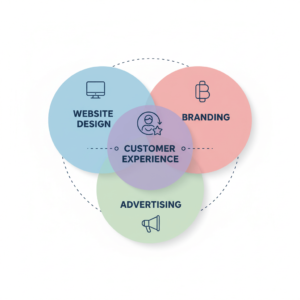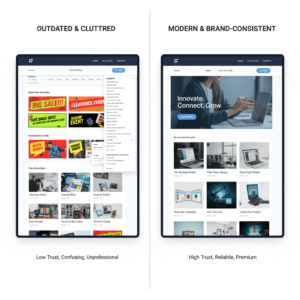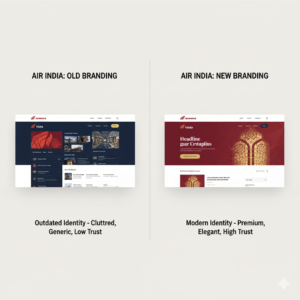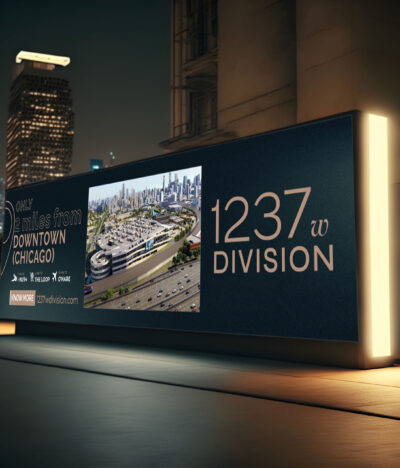Your website is more than just a digital presence — it’s your brand’s online identity, the core of your marketing and advertising strategy, and often the first impression potential customers have of your business. In today’s competitive digital landscape, website design, branding, and advertising must work together cohesively to build trust, attract attention, and drive conversions.
Let’s explore how aligning your website design with your brand identity and marketing efforts can significantly enhance visibility, credibility, and customer engagement — and ultimately help you win more customers.
1. The Connection Between Website Design, Branding, and Advertising
Think of your website as the digital extension of your brand. Every color, font, image, and layout choice sends a message about who you are and what you stand for. When your website design aligns perfectly with your branding and advertising, it creates a consistent experience that builds familiarity and trust among users.

For example:
If your advertising campaigns promote luxury and sophistication, but your website design looks outdated or cluttered, it breaks the connection — and potential customers lose confidence. Consistency in tone, visuals, and messaging across your website and ads strengthens your brand recall and encourages conversions.
2. Why Consistency Matters for Building Trust
Customers trust brands that feel familiar. When your website design matches your social media ads, packaging, and branding materials, users instantly recognize you — and that recognition drives trust.
Key benefits of consistent branding in web design:
-
Builds emotional connection and trust
-
Improves user experience and brand recall
-
Increases conversion rates and customer loyalty
-
Reinforces advertising efforts and message continuity
3. How Website Design Influences Customer Perception
Your website’s design directly impacts how customers perceive your business. Studies show that 75% of users judge a company’s credibility based on its website design.

Here’s how design shapes perception:
-
Colors: Communicate emotion — blue for trust, red for passion, green for growth.
-
Typography: Modern fonts convey professionalism; playful fonts suggest creativity.
-
Layout: Clean, structured designs feel trustworthy; cluttered designs feel cheap.
-
Imagery: High-quality visuals reflect brand quality and professionalism.
A well-crafted design aligned with your branding strategy ensures your visitors understand your values, vision, and credibility within seconds.
4. How Branding and Advertising Guide Web Design Strategy
Your brand identity defines your business personality — your tone of voice, visual identity, and customer promise. Advertising amplifies that message. Website design brings it all together in one interactive experience.
When building your website:
-
Use the same color palette and typography as in your ads and brand materials.
-
Highlight your unique selling proposition (USP) visually on the homepage.
-
Use ad-inspired copywriting and CTAs (Call to Action) to maintain tone consistency.
-
Integrate branded visuals, icons, and motion elements to enhance identity.
This unified approach creates a seamless journey — from the ad a customer clicks on, to the website they visit, and finally, to the purchase they make.
5. Website Design and Advertising: The Power Duo for Conversion
A visually consistent, brand-aligned website supports your advertising goals by ensuring visitors don’t just click — they convert. To understand how different advertising strategies influence customer behavior and conversions, check out this detailed guide from Amazon Ads on advertising strategy.
How They Work Together:
| Advertising Element | Web Design Impact |
|---|---|
| Ad Copy & Tone | Must match website messaging for trust |
| Ad Visuals | Should reflect same imagery & color scheme |
| Landing Page Design | Needs clear CTAs and brand tone consistency |
| Ad Campaign Goals | Should guide page structure and layout decisions |
When your website and ads feel connected, your conversion funnel becomes more effective — resulting in higher ROI from Google Ads, social media marketing, and PPC campaigns.
6. SEO Benefits of Brand-Aligned Website Design
A cohesive branding and website design doesn’t just attract users — it helps search engines understand your business better. Google rewards websites with consistent, clear branding and user-friendly experiences.
SEO advantages include:
-
Lower bounce rates (users stay longer on well-designed sites)
-
Improved engagement metrics (CTR, dwell time)
-
Stronger domain authority through brand trust
-
Easier keyword mapping and link building
For instance, if you’re a Manufacturer running digital campaigns, aligning your design, tone, and visuals helps Google identify your niche faster — improving local SEO rankings.
7. Case Study: Air India’s Digital Rebranding Transformation
A great example of strong branding integration in web design is Air India’s recent rebranding. Their new website reflects the brand’s modern identity, global appeal, and luxurious service experience.

-
Before: The old site was functional but outdated, lacking brand emotion.
-
After: The new site showcases bold typography, elegant red-gold palettes, and improved UX — perfectly reflecting the airline’s premium positioning.
This redesign not only enhanced brand perception but also improved engagement and bookings — a perfect blend of branding, advertising, and design.
8. Common Mistakes Businesses Make
Avoid these pitfalls that dilute your brand and hurt conversions:
❌ Inconsistent fonts, colors, and tone across web pages
❌ Stock images that don’t match brand values
❌ Ignoring advertising tone in web copy
❌ Overloaded homepage with mixed messages
A simple rule: If your ad looks different from your website, you’re confusing your customer.
9. How to Align Website Design with Branding and Marketing Strategy
Here’s how you can unify your digital presence:
-
Create a Brand Style Guide: Define fonts, colors, imagery, and tone.
-
Audit Your Current Website: Identify mismatched elements.
-
Design Branded Landing Pages: For each campaign or ad group.
-
Integrate Marketing Analytics Tools: Measure ad-to-website conversion behavior.
-
Work with Experts: A professional branding and web design agency can align your visuals, tone, and SEO strategy seamlessly.
At Popcorn Branding Agency, we specialize in integrating website design, SEO, and digital marketing to create cohesive brand experiences that convert.
FAQs – Website Design, Branding, and Advertising
Q1. How does branding affect website design?
Branding defines the colors, fonts, tone, and visuals that your website uses. Strong branding ensures design consistency and builds user trust.
Q2. Can advertising and web design influence SEO rankings?
Yes. Cohesive ad messaging and design reduce bounce rates and improve user engagement, both of which are key SEO ranking factors.
Q3. How often should I update my website design?
Every 2–3 years or when your branding or marketing strategy changes significantly.
Q4. Should my landing pages look different from my main website?
They can be simplified versions, but must maintain the same brand identity, color scheme, and tone for consistency.
Q5. What are the best tools to ensure branding consistency online?
Use tools like Figma for design collaboration, Google Analytics for performance tracking, and Canva/Adobe for branded content creation.
Conclusion
Your website design isn’t just a visual asset — it’s the digital embodiment of your branding and advertising strategy. When all three align, your business builds trust, enhances visibility, and drives stronger customer relationships.
If you want to create a powerful online presence that connects, converts, and grows, collaborate with Popcorn Branding Agency — a leading website design, branding, and digital marketing company in Vadodara. Our experts ensure your website not only looks great but also works hard to represent your brand authentically and effectively.







